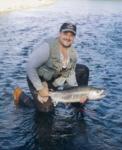LOL. I'll cut/paste this here too. I have friends/ghillies in the UK (have fished there a few times). Have a couple UK boards I go to, some of them are on them. But here is a response on one of them from a writer who originally did story about fish feeling no pain and his reply msg from scientist who did it originally.
Hello all,
I'm the fishing journalist who broke the original story that fish don't feel pain. It was done by Professor Rose of the University of Wyoming.
I wrote it for Trout and Salmon and it was then followed up, as you know, by other print media.
Having been contacted by everyone at the Beeb from the Today programme downwards (!) I sent the Sneddon report to Professor Rose.
This is his reply: Graham,
As you might have guessed, I've been contacted by several writers about the Sneddon paper already. I've copied, for your information, my reply to a writer for Nature.
The Royal Society paper by Sneddon, et al. does not actually deal with pain. It deals only with nociception. I have already addressed the kinds of conceptual confusions that undermine the paper by Sneddon et al. in my 2002 Reviews in Fisheries Science Paper. They did not cite this paper and apparently haven't read it.
The flaws in their argument include the following. Their definitions of pain and nociception are misleading. Pain, as defined by investigators who study it (e.g. the International Association for the Study of Pain) is purely a conscious experience, with a sensory and emotional component. The detection, processing and transmission of information related to injury is nociception, unconscious and not pain. Contrary to the assertions of Sneddon, et al. behaviors more complex than reflexes are are frequently purely nociceptive as well. For example, humans with extensive damage or dysfunction of the neocortex in the cerebral hemispheres can still make facial displays, vocalizations, and show struggling and avoidance reactions in response to nociceptive stimuli, but they are unconscious and unable to experience pain. By the definition of pain used by Sneddon et al. it would be concluded that these unconscious humans are feeling pain rather than making purely nociceptive responses, which is clearly erroneous. Secondly, a sustained change in behaavioral activity in response to a sustained nociceptive stimulus (like the bee venom or acid injection in the jaw), shows nothing more that that behavior can be persistently changed if a nociceptive stumulus is sustained. In light of the probable intensity and sustained nature of this noxious stimulus, it is quite likely that a physiological and/or endocrine stress response was elicited in the trout to a much greater degree than procedues to which control fish were exposed. A physiological response of this type is known to alter the ongoing behavior and physiological function of trout and is perfectly understandable, but it is not evidence of a pain experience. I'm quite surprised that the authors of this paper didn't thoroughly consider the confounding implications of the likelihood of a physiological and/or endocrine stress response.
In order to show that a fish experiences pain it is necessary to show that a fish has consciousness. Without consciousness, there is no pain. Nothing in the information presented in this paper necessitates predication of consciousness for its explanation. Furthermore, from the extensive knowledge that exists on the neural basis of consciousness, there is no basis for assuming that a fish might have such a capacity. Only anthropomorphic speculation would lead one to conclude that the trout in this study are experiencing pain. Complex behaviors are known to occur without conscious mediation, even in humans, and the fact that there are nociceptive reactions of trout to sustained, noxioius stimuli in no way justifies a conclusion that these fish have a capacity for the conscious experience of pain.
Regards,
Jim Rose
James D. Rose, Ph.D.
Department of Zoology and Physiology
University of Wyoming
Laramie, WY 82071
USA
Phone: 307-766-6719
Fax: 307-766-5625
e-mail: trout@uwyo.edu

















 Previous Topic
Previous Topic Index
Index

